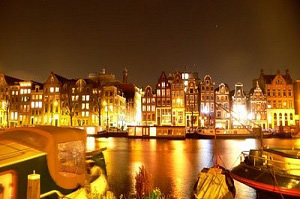
Amsterdam Museums
Amsterdam generally attracts two types of visitors: those that come for the coffee shops and the Red Light District, and those that come for history and museums. Indeed, the cultural offer of the city is of a level to compete with other world capitals. The primary museums are the Rijksmuseum and the van Goghmuseum, which respectively offer the best art of the Dutch Golden Age and of the most famous painter, Vincent van Gogh. Another place that is not to be missed is the Anne Frank House, where the young Jewish girl and her family hid for the Germans from 1942 until their betrayal two years later. But apart from these three hotshots, Amsterdam offers the option to visit museums for modern art or history, a hidden Catholic Church (Museum Amstelkring), the Rembrandthuis (former home of the painter), 18th century canal houses (Willet-Holthuysen), and houseboats. There are even ‘less serious’ museums for those attracted to the other traits of Amsterdam, such as the Sex Museum and the Hash, Marihuana and Hemp Museum.
Stedelijk Museum (City Museum; Modern Art museum), Oosterdokkade 5
Amsterdam historisch museum (Amsterdam historic museum), Kalverstraat 290
Museum Amstelkring (Our Lord in the Attic), Oudezijdse Voorburgwal 40
Rembrandthuis, Jodenbreestraat 4-6
Museum Willet-Holthuysen, Herengracht 605
Houseboat Museum, Prinsengracht 296
Sex Museum, Damrak 18
Hash, Marihuana and Hemp Museum, Oudezijdse Achterburgwal 148
Rijksmuseum and van Goghmuseum
The two most important museums in Amsterdam are the Rijksmuseum and the van Goghmuseum. The Rijksmuseum offers the best of the rich paintings of the Dutch Golden Age, the heyday of Dutch art and Dutch society. In these years, Dutch art produced masters as Johannes Vermeer, Jan Steen, Frans Hals and, the biggest of them all, Rembrandt van Rijn. Rembrandt (1606-1669) is seen as the most famous classic painter worldwide and is praised for his amazing talent to deal with the contrast between light and dark. The museum hosts classics as Rembrandt’s Nightwatch and Vermeer’s Milk Maid. Other valuable works are the winter landscapes of Hendrik Avercamp and the lively family tables of Jan Steen. The nearby van Goghmuseum dedicates its collection to this other Dutch world-class painter, Vincent van Gogh (1853-1890). As a member of the impressionist current in painting, van Gogh’s was renowned for the bright and lively colours of his works. Many of his most precious canvasses, such as The Bridge at Arles, the Potato Eaters or his series about sunflowers are exhibited in the van Goghmuseum. Be reminded that you can buy tickets in advance for both museums in order to save some waiting time.
Rijksmuseum, Hobbemastraat 21
Van Goghmuseum, Paulus Potterstraat 7
Anne Frank House
More than sixty years after she died from typhus in the German extermination camp of Bergen-Belsen, Anne Frank is without any doubt Hitler’s most famous victim. When the Nazis occupied the Netherlands and reduced the remaining freedoms of Jews one after another, Anne Frank and her family hid in the back house of father Frank’s office in Prinsengracht. For two years, they spent all their days together in these small spaces. During these years, the young Anne kept a diary that she edited and improved over time with the dream to publish it in a later stage. After their arrest, the book was found by one of their helpers and published when the war was over. The diary subsequently was translated in many different languages. Since 1960, the house is open for the public to see the circumstances in which the family lived and to acquire knowledge about the brutality of the holocaust. Recently, an up-to-date exhibition that challenges clear-cut opinions about the width of human rights has been added. The Anne Frank foundation is also very active in this field.
Anne Frankhuis, Prinsengracht 263
